By Ron McNew
Photos and videos by author
Escape rooms have exploded in popularity in recent years, offering a unique and immersive entertainment experience. These themed adventures lock participants in a room, challenging them to decipher puzzles, work together, and ultimately escape within a set time limit. But the appeal goes beyond just a thrilling experience. Escape rooms offer a surprising number of benefits that can translate into a more productive and positive workplace, perhaps especially for firefighters.
The core reason for escape rooms’ success lies in their ability to tap into our natural desire for challenge and accomplishment. The puzzles and riddles require creative thinking and teamwork, fostering a sense of camaraderie and shared purpose. The ticking clock adds a layer of pressure, pushing participants to think innovatively and communicate effectively. Success brings the participants a great deal of satisfaction, reinforcing the value of collaboration and problem-solving.
- Building Better Company Training
- Firefighter Training Ideas: 52 Weekly Firefighter Skill Drills
- 101 Drills for the Company Officer
This kind of challenge translates perfectly into the fire service. Team-building exercises based on escape rooms strengthens communication and collaboration skills within a team. As participants work together to solve the problems, they learn to identify each other’s strengths and weaknesses, fostering trust and appreciation. Escape room exercises encourage creative problem-solving and critical thinking, critical fire service skills. The shared experience of facing challenges and ultimately succeeding can create a stronger sense of team spirit and camaraderie, leading to a more positive and productive work environment.
The Fairfax County (VA) Fire and Rescue Department recently developed a series of fire training exercises modeled after the escape room concept. Based on real fire department skill requirements, the evolutions are challenging, develop critical problem-solving skills, demand the utmost in teamwork, encourage competition among companies and battalions, and, crucially, they’re fun. The newest rookie has an equal footing with the most seasoned veteran in identifying a solution. The training scenario outlined below can be followed, or other firefighter training ideas can be incorporated into the basic framework. A note of special thanks to Technicians Paul Kaulfers and Gary Reuter for their expertise and assistance, and additional thanks to my coworkers and officer for their contributions and support. Thanks, too, to Dr. Denis Onieal for his encouragement, guidance, and support.
Overview
The Escape Room is a time-based competitive drill designed for the crew/company to complete various tasks, skills, and problem-solving puzzles to reach a final objective.
The skills involved include:
- Team building
- Communication
- Attention to details
- Following instructions
- Problem solving
- Forcible entry of a vehicle
- Forcible entry (through-the-lock)
- Ropes and knots knowledge
- Hydraulics
- Thermal image usage
- Searching in zero visibility
- Chainsaw assembly and usage
- Operating a UTV
- GPS locating
- Use of multiple tools retrieved from apparatus
Crews are given a set of rules to follow and assigned a radio training channel. One team member is asked to volunteer to give up their cell phone to use as a timer. The phone is then locked in a box. The objective of the drill is to ultimately find the key to the lock, retrieve the phone, and stop the timer. Crews are allowed to ask for hints, but at a price: the first clue adds one minute to their time, the second clue adds two minutes, and so on. The driver of the crew then pulls into the station so they can use the tools from their rigs to complete the tasks. They are to use any tools they would normally use if this was a real call. They are dispatched on their first event and their time begins.
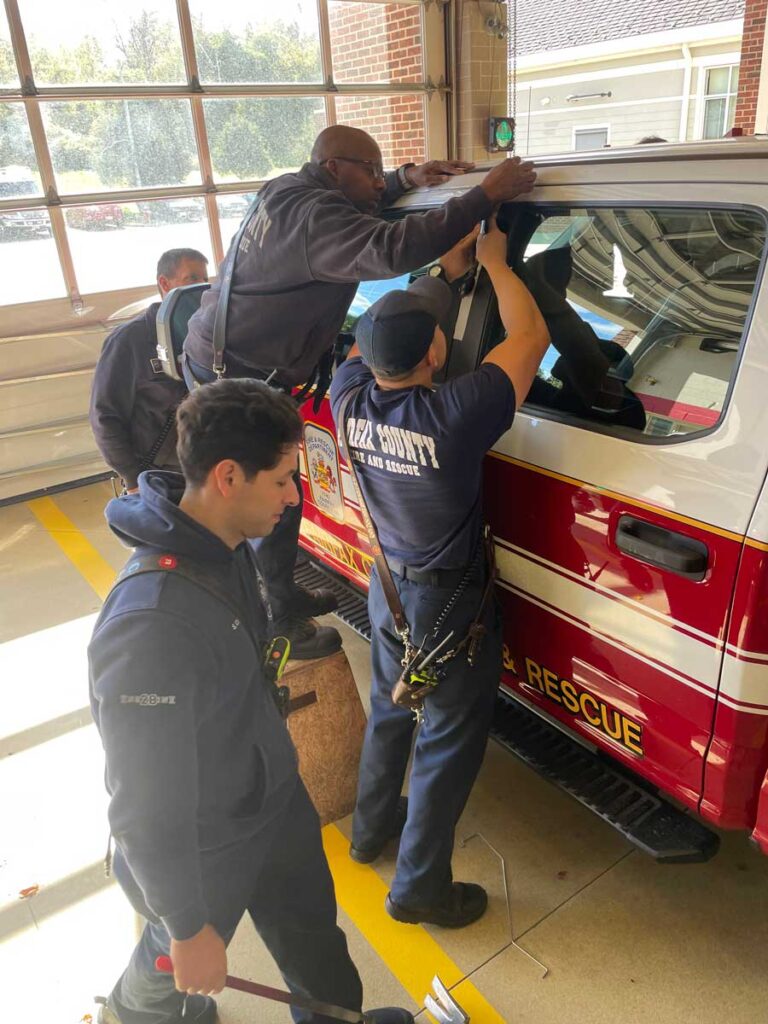

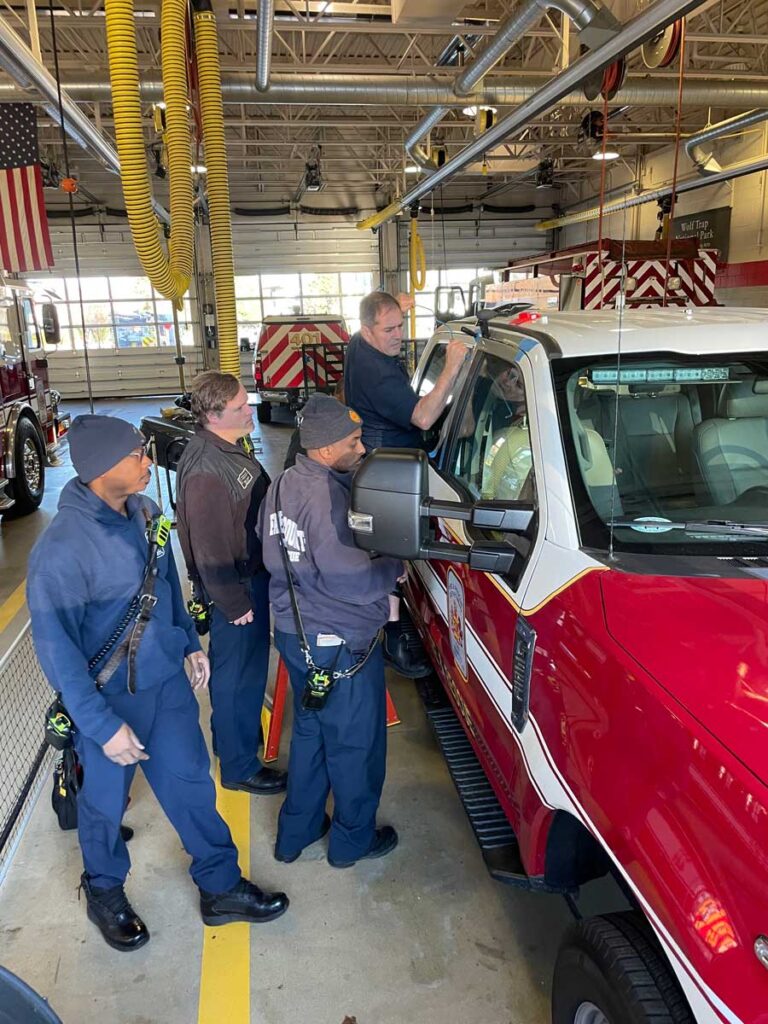

Evolution #1
Crews are dispatched for a baby locked in a vehicle. The mother locked the keys in the vehicle and they baby is not in distress…yet. The caller’s husband is on the way with a spare set of keys, with an ETA of 10 minutes. Crews have 10 minutes to break into the truck and get the baby out, along with a clue to their next task to complete. At the 10-minute mark, the doors will automatically be opened and the drill will continue.
Working as a team, members get various equipment, proceed to the vehicle, and split up to work on multiple tasks at once. One member walks around the vehicle trying each door and looking under the truck for a hidden spare key. Another member brings EMS supplies and gets a general impression of the baby. The officer will make contact with the mother of the baby. The rest of the crew goes to work on the door(s). Once the lock is popped—or the 10 minutes is up—the crews make their way inside, assess the baby, and find an envelope with another radio channel where they are dispatched on their next task.
Tips on using lock-in kit tools
- Using plastic or wood chocks will do less damage to the vehicle as opposed to using metal chocks.
- Multiple chocks will open the space more to be able to manipulate the unlocking rod tool in more positions.
- Using a mini-air bag or “BP Cuff” type bag or actual cuff can create a space without causing much damage to an auto.
- Working from a small ladder can enhance overall operations.
- Placing duct tape on the vehicle’s body will lessen any damage caused by using the metal unlocking rods.
- Sometimes, when hitting the unlocking button, a different door may unlock other than the door you have wedged open.
- In an emergency, a window can be broken to access a patient with a severe medical condition that’s presenting.

Evolution #2
The crew is dispatched for a lockout of an apartment with food on the stove. They are specifically asked not to break the door jamb like the last crew did, but it is okay if they break the lock. Unfortunately, the K-tool is missing from the rig. This is a through-the-lock forcible entry, a great skill to master because it will minimize damage to the door for the homeowner, who is already stressed by having to call 911. Another scenario is lift assists and non-emergent medic calls, where we have to force the door to get to the patient. Less damage means less stress for the patient.
This evolution will make use of prying and striking skills, teamwork and at times, a little bit of patience. Firefighters are presented with a wooden, inward swinging-door, so crews must select the proper tools they need and discuss how they want to approach this task. They will try and pop the lock off the door so they can manipulate the bolt open. Different techniques may work for different people.
Tips on through-the-lock tactics:
- With some cylinders, it may be easy to unthread or snap the outside head off with a vise-grip or large pliers. Some companies practice removing them by using a cordless drill to drill out the two attachment screws.
- The pike of the A-tool can often be used to manipulate a lock open, especially in the “5 to 7” or “7 to 5” maneuver.
- If there isn’t a deadbolt on the door, removing the door handle and sliding the mechanism may open the door.
- When first using the A-tool, start at an angle, which may allow you to get an initial bite into the lock.
- Prying upward and downward with pulling tools may enable the lock to snap out of the door easier.
- Always use caution inserting a finger into the door. Sharp metal edges can slice your finger open, requiring medical attention. Try the lock picks first!
- Size-up the structure for an open window, portable ladder access, or using a Slim-Jim type tool to slide a lock open on a window.
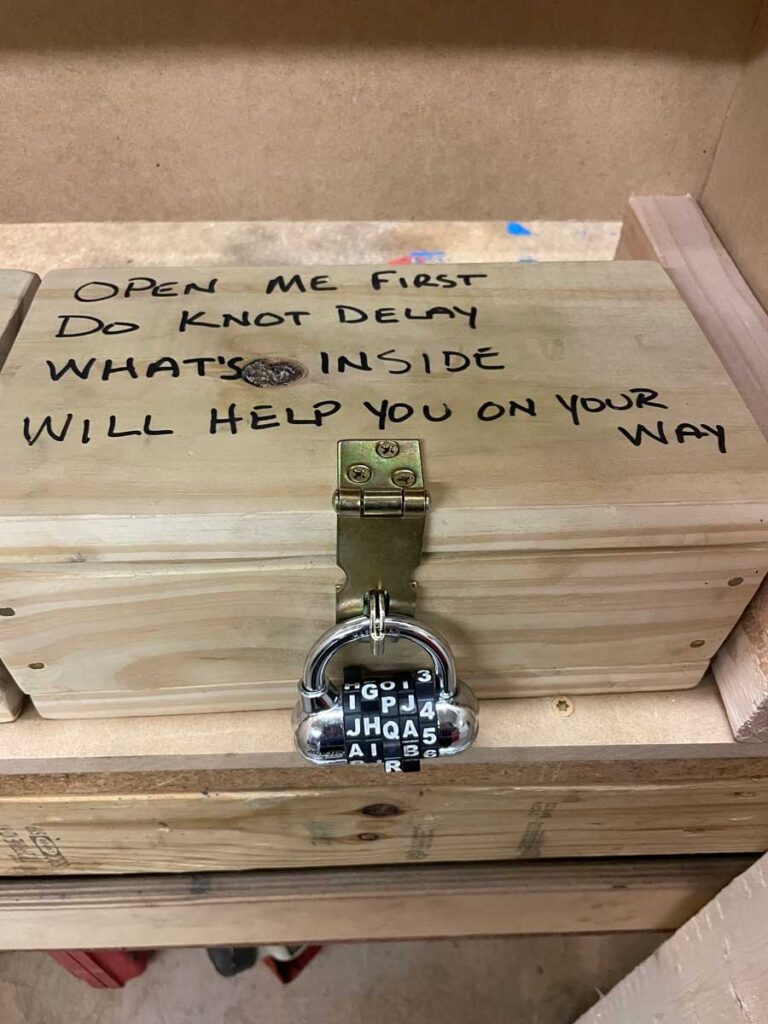
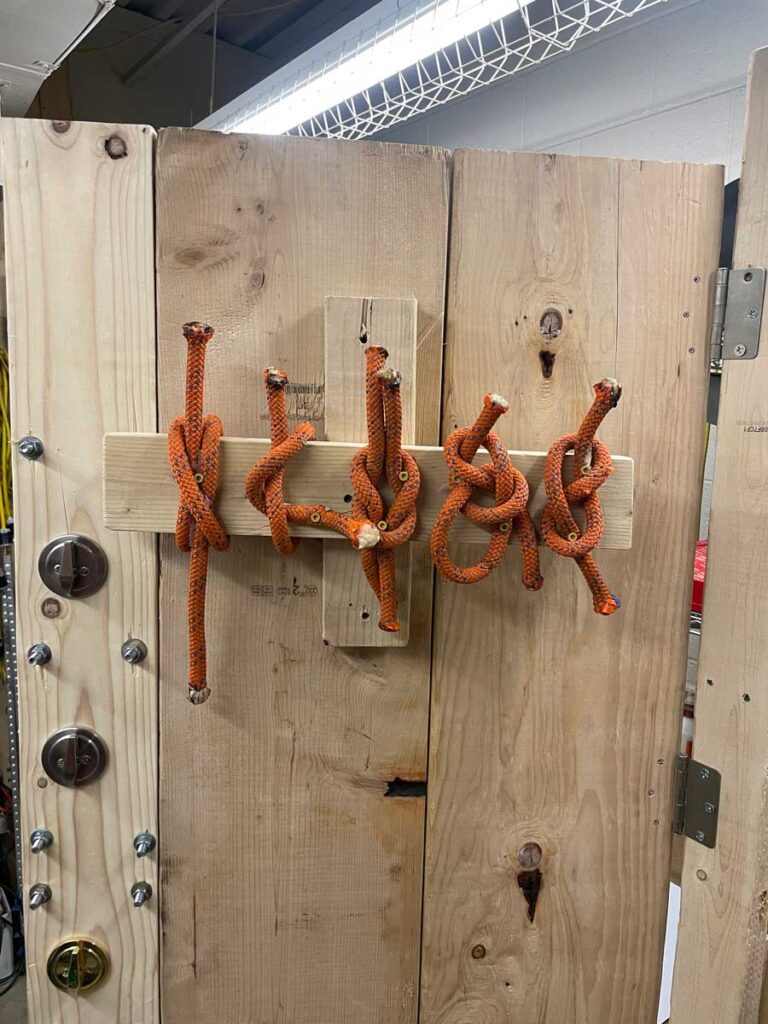
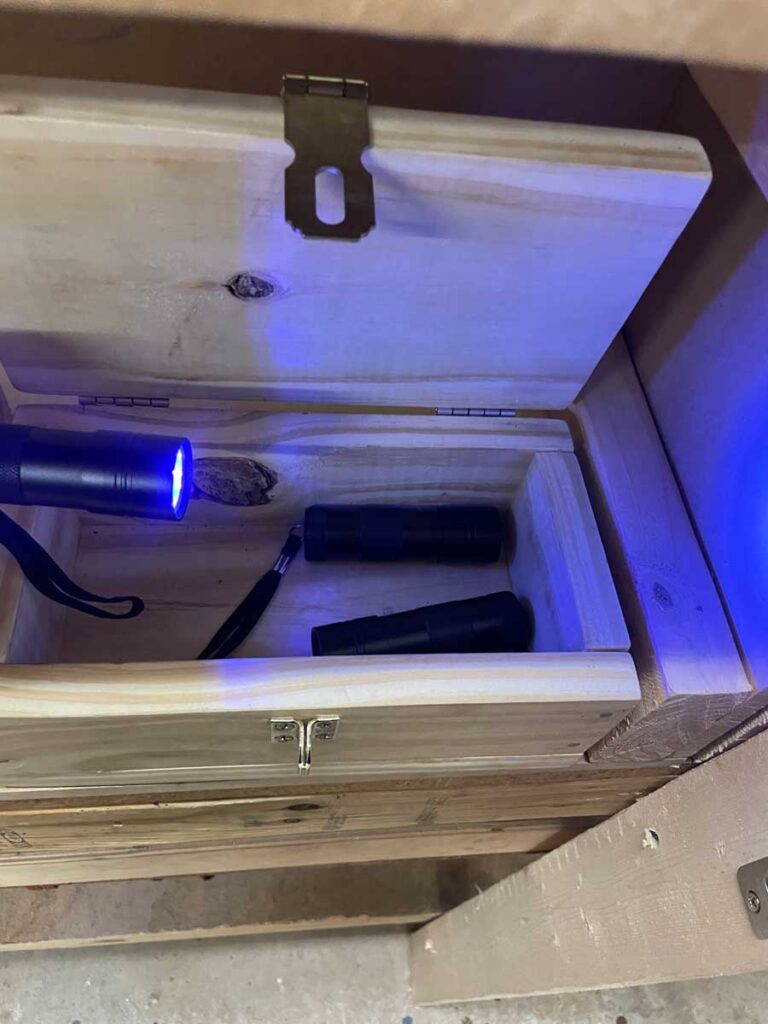
Evolution #3
The crew has gotten through the lock and opened the door to find two boxes with combination locks on them. Written on top of one of them is:
OPEN ME FIRST
DO KNOT DELAY
WHAT’S INSIDE
WILL HELP YOU ON YOUR WAY
This lock is a series of letters and numbers, and the crew must figure out the code for the lock. Now they must use their attention to detail, situational awareness, and problem-solving skills to figure out how to proceed. On the back of the door are a series of five knots that need to be identified to obtain the combination for the lock. Each knot will correlate to a specific tumbler on the lock. Once they find the correct combination, they unlock the box to get a clue to their next task.
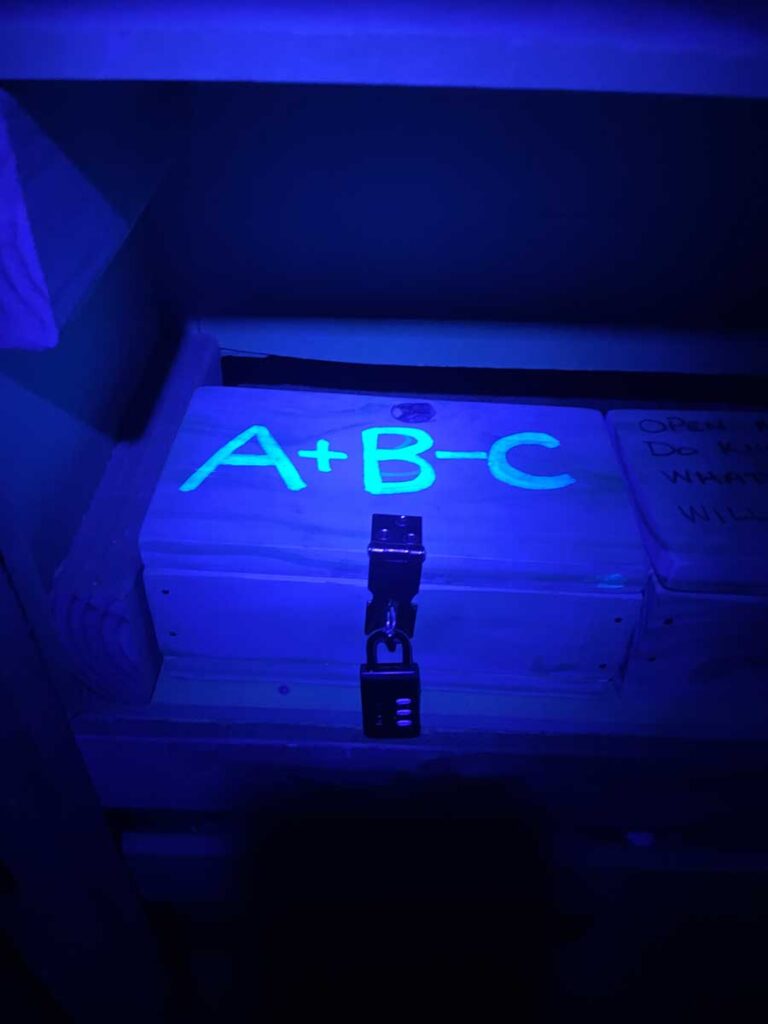
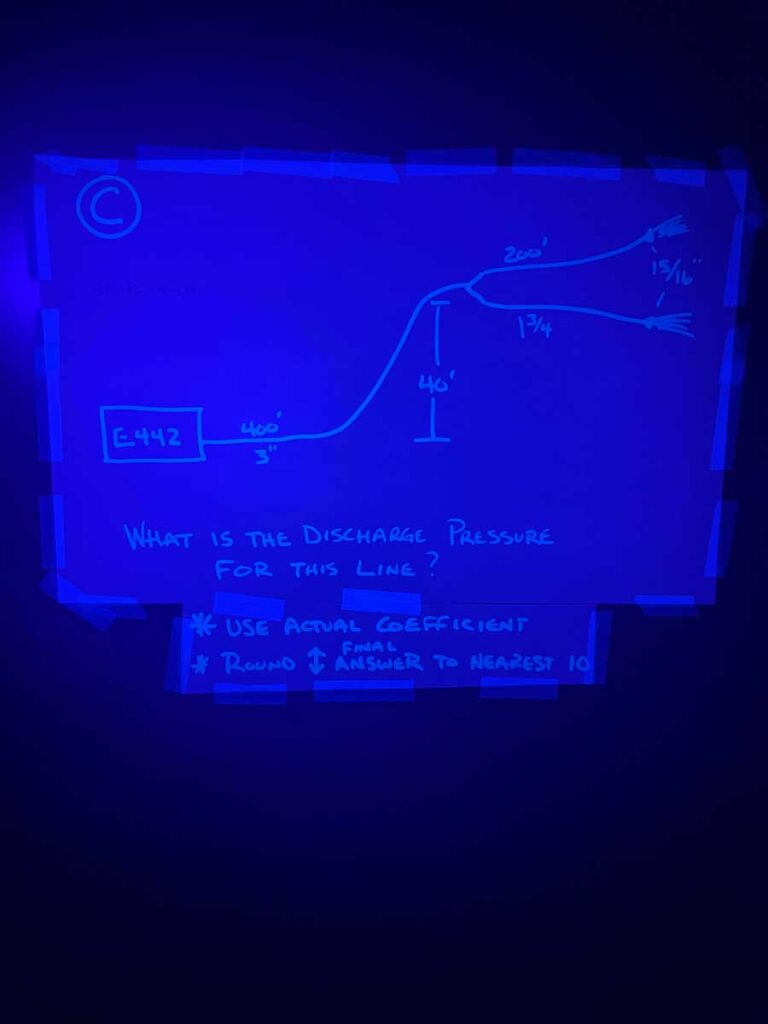
Evolution #4
Once the crew finds the black light flashlights from the previous evolution, they hopefully will realize they need to turn the lights off and search for more clues. On top of the second lock box is a formula written in invisible ink that gives a clue on how to get the combination. Written on the box is “A+B-C.” They soon learn there will be three clues (dealing with hydraulics) to find to help get the combination. Now we begin the search. The three clues can be any questions you come up with that have a number for an answer.
In this case:
- A asks what the flow of a specific nozzle is (this happens to be a new nozzle the department just placed in service on all the engines).
- B asks a question about a specific gpm requirement on a rural water supply scenario.
- C is a basic pumping scenario taken out of our department’s hydraulics manual and asks for the total pump discharge pressure of the engine.
This part of the evolution focused on engine driver operations and knowledge. These three questions dealt with hydraulics, however the questions in this room could just as easily be centered on truck or rescue knowledge; the choice is yours.
Once firefighters have the correct numbers, they add A and B and subtract C and come up with the three-digit combination to open the box, which gives them a new radio channel to markup on to get the dispatch for their next evolution.
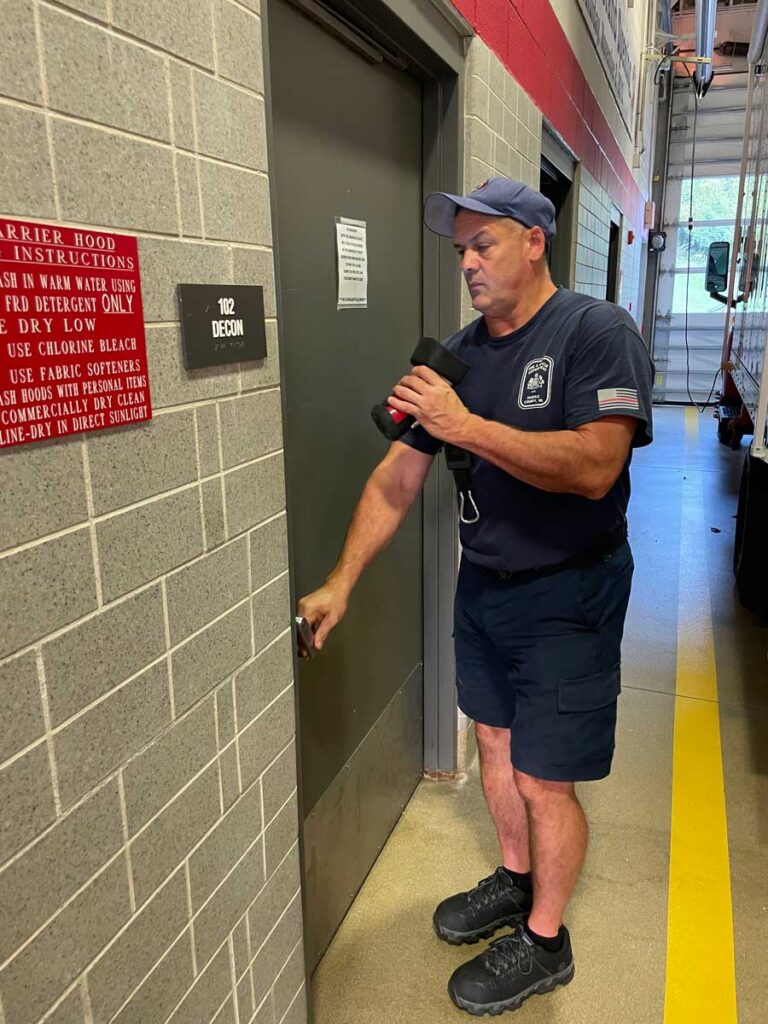

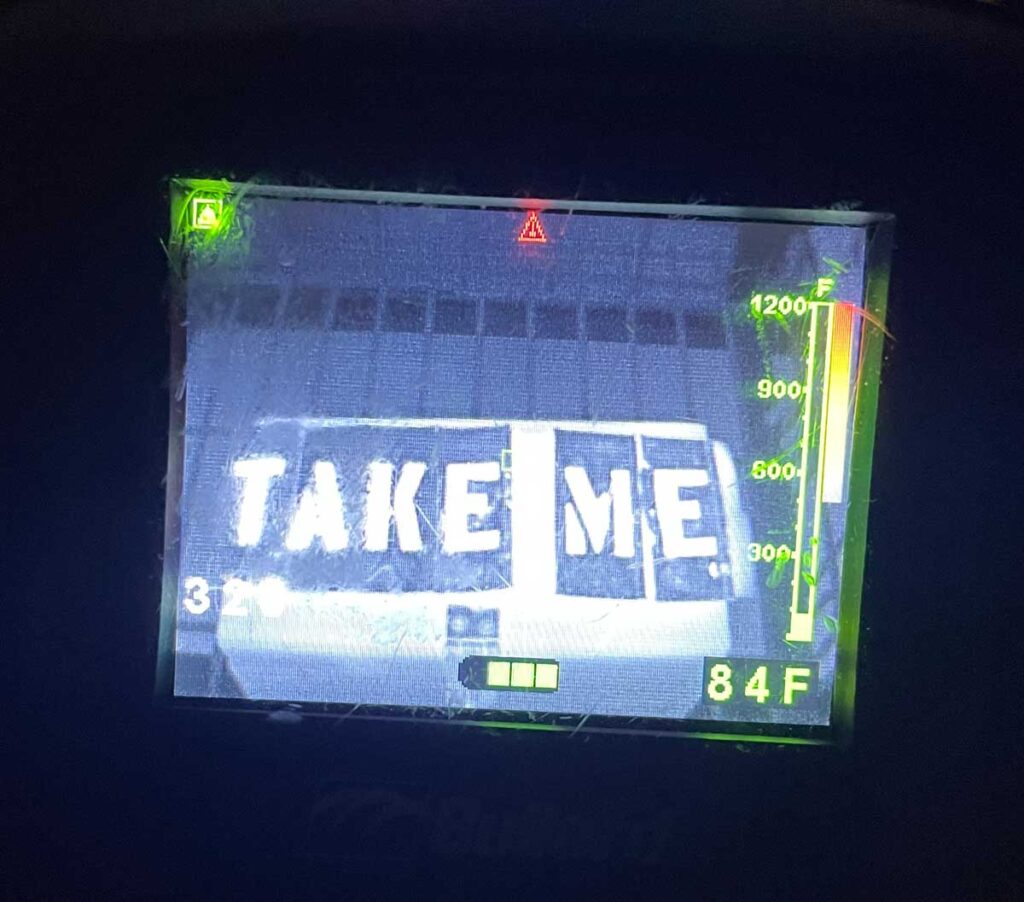
Evolution #5
In this evolution, the crew is dispatched for smoke in a building because of a lightning strike that knocked the power out. As they approach the door to the address, they see a sign with instructions which let them know they need to find four clues and suggest what tool they will need to find them by letting them know to hurry up because “time is TIC-ing.” As they enter to zero visibility, they will use a thermal imager to locate four clues that were heated up with a heat gun prior to their entry. Three of the clues are words that will be used in the next evolution and the other is a box containing a radio channel, a chainsaw wrench and a clue as to how to proceed.
Evolution #6
This evolution will require teamwork as there are multiple tasks to complete at once. The crew will find that, while they were in the zero-visibility room, someone removed the chain saw from their rig and disassembled it. Lucky for them, one of the items they found in the previous evolution happens to be a tool to help assemble it. The crew marks up on the new radio channel they found in the previous evolution and are dispatched for a fallen tree that needs to be cut up. The caller was unable to provide an address but mumbled something about three words before he hung up. Along with assembling the chain saw, this evolution uses a Geolocation app, and quite conveniently, the crew happened to find three words hidden in the last evolution. As several members work on putting the saw back together, the other will put the words into the app and get the location to their next evolution.

Download the app in question on a department Ipad or phone. This will enable the members of the crew to use their phones for personal needs.
Some tips regarding the saw:
- Always check for dull or broken teeth on the chain and ensure it is facing the correct direction.
- Be sure the bar is clean and free of damage.
- Do not overtighten the chain when adjusting the set screw.
- Before starting, you should be able to slide the chain with the brake off, but with some tension.
- Be sure the fuel and bar oil are both full, the brake is applied and you have appropriate personal protective equipment on before starting.
- Look over the tree/log before cutting to ensure you are using the proper angle to avoid pinching the bar.
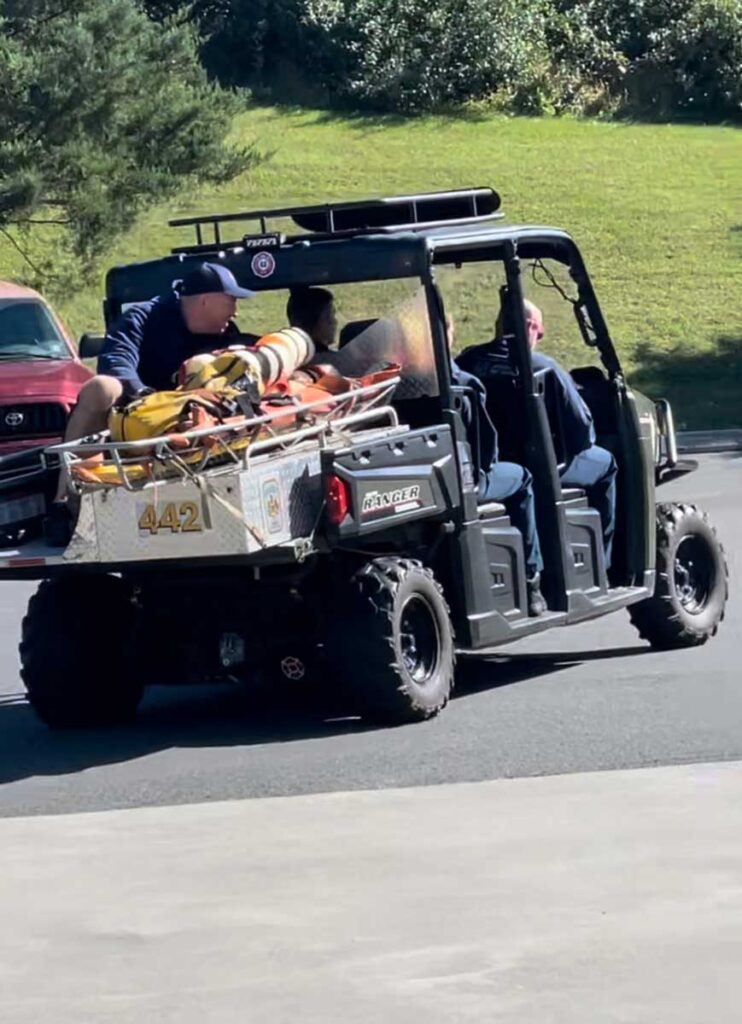
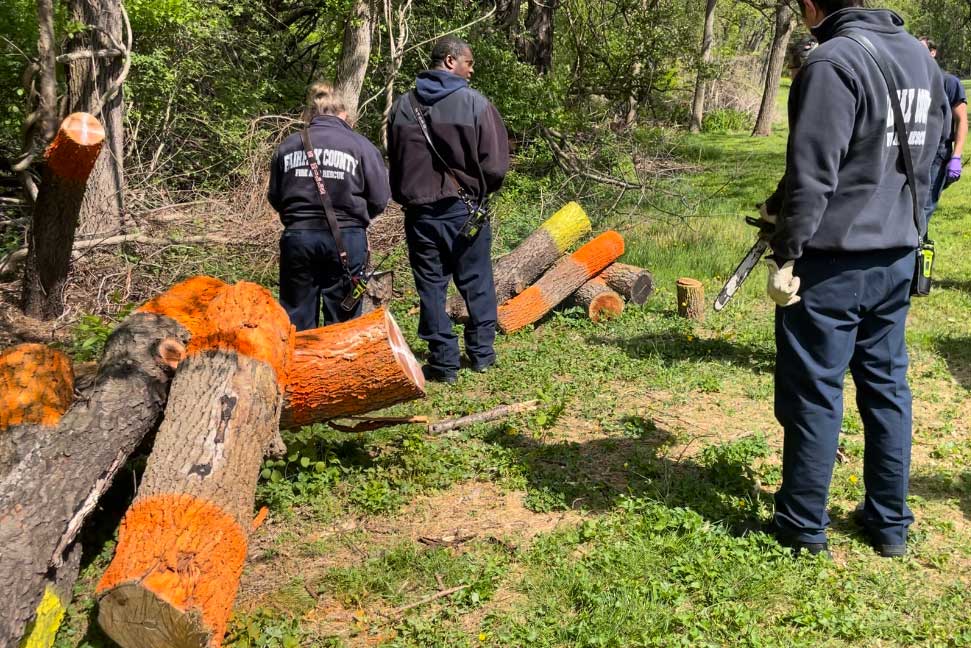
Evolution #7
This evolution begins with the completion of the last one. Once the chain saw is assembled and tested, and the location of the fallen tree is found, the crew will hop on the UTV and take a ride to where the app takes them. The app we use can geolocate anyone, anywhere in the world, using only three words, and is useful for search operations. Using the app, participants navigate through a series of trails to come out to a field where there are logs to cut up. The logs have been marked so the crew knows which ones they can choose from. A sign at the scene explains they are to cut one log on the painted line. The sign also explains there are three more words hidden somewhere on the UTV they need to find which will take them to their next evolution. Once the three words are found, the crew hops back on the UTV with the log they just cut and heads to their next evolution.
Evolution #8
Once the crew has the log and the three words that were located on the UTV from the app, they willhead to the location, where they will find a sign that instructs the crew on how to proceed. They must place the log they cut on a stump and go get a tool that “turns one into two.” A crew member will retrieve an ax, place the log, and split in in half. If done properly, the crew will find a surprise hidden inside the log the just split…a plastic bag with a key and instructions telling them they just found the key to open the box and stop the timer.

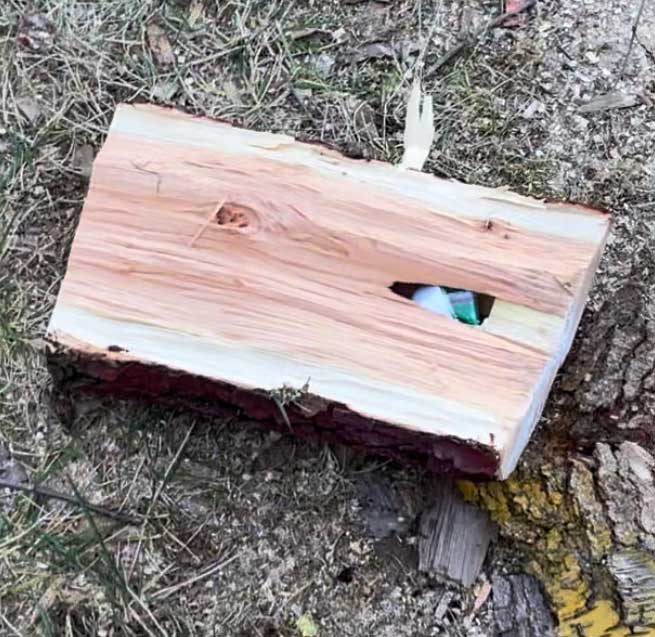
For this part of the drill the logs were pre-drilled before the evolution. An 1 ¼-foot wood bit was used to drill a hole approximately six inches deep. They key, along with a clue, was inserted into the hole and a two-inch dowel was glued into the opening to seal it.
Some ax tips:
- Axes and other striking tools aren’t something used on a regular basis. They must be kept clean and in good working order with handles that are not loose and free of cracks.
- Remember too keep the edges sharp, strike square to the surface, and avoid glancing hits.
- Always use caution when striking items on an uneven surface. Be cautious of your footing
- The ax head can be place in numerous positions and struck with another tool to act as a wedge or cutting head.
Escape room training scenarios will enable your firefighter to train many skills in a short time span. Being efficient with skills, as well as teamwork, can make quick work of the most basic tasks. A well-oiled machine can do wonders when all the parts work well together. Best of all, these scenarios can enliven your company training and build your team’s coordination and camaraderie at the same time.
Ron McNew is an apparatus technician with the Fairfax County (VA) Fire and Rescue Department, where he’s been since 2004. He is assigned to Wolftrap Fire Station 42 as the engine driver on B-shift. He can be reached at rmcnew442@gmail.com..

